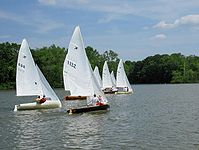Jet 14
| Current Specifications | |
|---|---|
 | |
| Crew | 2 |
| LOA | 14 ft 1 in (4.29 m) |
| LWL | 13 ft 11 in (4.24 m) |
| Beam | 4 ft 8 in (1.42 m) |
| Draft | 4 to 4.2 ft (1.2 to 1.3 m) |
| Hull weight | 285 lb (129 kg) |
| Mainsail area | 75 sq ft (7.0 m2) |
| Jib / Genoa area | 38 sq ft (3.5 m2) |
| Spinnaker area | 150 sq ft (14 m2) |
| D-PN | 97.2 [1] |
| PHRF | 253 |
The Jet 14 sailboat is a One-Design racing dinghy. The fleets are organized by the Jet 14 Class Association, which is broken into four divisions based upon geographical locations of the fleets. District I is in New Jersey, District II is in Ohio, District III is in Maryland, and District IV is in upstate New York. A variety of events are held for the jets all year, with the major events being the Silver Chevron competition and the Jet 14 Nationals. Clubs often host other Jet 14 regattas during the sailing season that all members of the Class Association and people wishing to learn more about sailing are welcome to attend.
History
The Jet 14 traces its origins back to the early 1950s, when several skippers were complaining about the state of one-design racing. The boats of the era were either too big or too small, too tricky or too slow, most were far too expensive and of the remaining classes many were not particularly adherent to the One-Design principles. It was because of these issues and dissatisfaction that the first of the Jet 14s were created.
The Jet 14 was based around several principles. All boats had to have strict adherence to the One-Design rules in regards to speed-producing elements, had to have good performance both all-around and when planing, have minimal initial and maintenance costs, and be easy to transport from one location to another.
Howard Siddons created the first Jet 14 in 1955 by combining the sailing rig of a Snipe with the hull design of an Uffa Fox International 14. The hulls were readily available, had low maintenance costs, and were capable of planing under the right conditions. The design worked exceptionally well, and Siddons, with the help of Harry Sindle, created the first of the Jet 14 boats.
Siddons came up with a hull design that was modified in the interior in order to minimize maintenance and building difficulties. The hull was decked over to keep water from coming into the boat, the spars were kept solid, and sail tracks were added in order to make things easier for amateur boat builders. A metal centerboard was used in order to eliminate expensive and cumbersome lead castings that were used for weight and balance with the boats. Plans, patterns, and instructions were then created so that sailors could build their own boats from stock materials available at any lumber yard if they so desired.
The boat design was incredibly balanced. While the boat was initially believed to be too powerful for adolescents, it was soon determined that some of the design features made it quite adaptable for crews of all shapes and sizes. The metal centerboard lowered the center of gravity, making capsizing more difficult. The smaller sail plan made handling in rough weather easier for smaller crews, and even if the boat did capsize, they will typically float on edge instead of turtling. Because of the size and balance of a boat, crews do not need to include a large member (often called a gorilla) to help keep control in foul weather, like larger two-person boats often do.
The Class association has added some modifications since the initial implementation of the boat's design. Fiberglass hulls first began appearing in 1960, followed by aluminum spars in 1962. The addition of self-rescue or "tanked" boats (so called for the built-in flotation tanks) occurred in 1965. None of these additions particularly affected the speed of the boat, but in 1970, the Class Association approved the use of a spinnaker in the Nationals, as well as a mid-boom traveler and furling gear.
History of the Class Association
The Class Association was started April 17th, 1955 to manage the business side of the class, such as expenses, organization of regattas, and protecting the one-design features of the Jet 14. The official boat specifications were established in 1956. Members of the class association had to pay dues, which covered various administrative and legal costs (such as registering the Jet-14 trademark in 1957), and official measurement certificates were drawn up and distributed. A constitution and by-laws were established for the Class as well. The first Class newsletter, "Jet Blasts," was published and a regatta schedule was created.
The Class Association continues to watch over and improve all aspects of Jet-14 sailing. From the approval of use for the spinnaker (1970), to the 720 rule (1974 Nationals) to the addition of the Silver Chevron Regatta (1976), the class continues to promote good sailing values for all of its member fleets. The class celebrated its 50th anniversary in 2005 and currently sanctions nearly 30 regattas per year. The Senior and Junior National Championships are contested each August.
Beginning in mid-2007, new Jet-14 sailboats have been produced by Allen Boat Company, of Buffalo, New York. Over 1,150 boats have been made by many different builders. There are currently 8 active fleets.
Based on the hull of the International 14 (I-14), a former Olympic class boat, the Jet is a plum-bow two-person sloop-rigged sailboat. The Jet 14 provides moderate-level performance for a dinghy sailboat. It does not require features such as a trapeze harness, although the hull is capable of planing.
The Jet 14 has a 2008 Portsmouth Yardstick rating of 97.2.
Notes
See also
Sailing
One-Design
Sloop
International 14
Snipe
